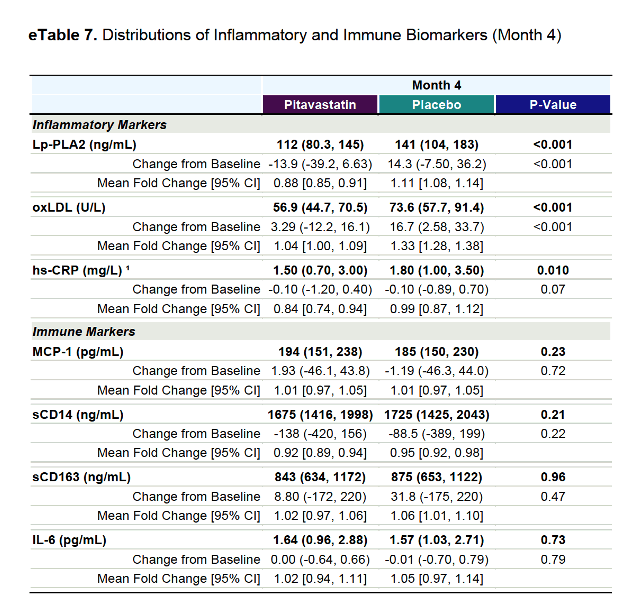| |
Effects of Pitavastatin on Coronary Artery
Disease and Inflammatory Biomarkers in HIV
|
| |
| |
Mechanistic Substudy of the REPRIEVE Randomized Clinical Trial
Download the PDF
Download the PDF
Feb 21 2024
The pitavastatin arm had a reduction in oxLDL and LpPLA2 compared with the placebo arm, in addition to LDL cholesterol. These changes are notable, as specific inflammatory pathways have been hypothesized to increase the risk of CVD in PWH.4 Prior studies have shown increased arterial inflammation using fludeoxyglucose-18 positron emission tomography in PWH compared with controls without HIV in the general population,37 linking arterial inflammation to noncalcified plaque among PWH.38 In this regard, LpPLA2 is a platelet-activating factor that hydrolyzes oxidized lipids, thought to play a proinflammatory role in atherogenesis and is a marker of arterial inflammation in PWH.39,40 In contrast, markers of generalized inflammation, such as CRP, may not be increased in well-treated PWH taking antiretroviral therapy, potentially explaining the more modest changes in CRP observed in our study. oxLDL is a marker of oxidative stress, which increases the atherogenic properties of LDL cholesterol and induces foam cell formation through localized macrophage activation and endothelial activation, key processes in plaque formation.41 In contrast, no significant effects on immune pathways were found.
Key Points
Question Can pitavastatin reduce noncalcified coronary plaque and inflammatory biomarkers in people with HIV?
Findings In this substudy of the Randomized Trial to Prevent Vascular Events in HIV (REPRIEVE) including 611 people with HIV, compared with the placebo arm, the pitavastatin arm had a significant 7% relative reduction in noncalcified plaque. Pitavastatin use was associated with reductions in oxidized low-density lipoprotein cholesterol and lipoprotein-associated phospholipase A2.
Meaning In this study, among people with HIV at low to moderate cardiovascular risk, pitavastatin showed promise to reduce noncalcified coronary plaque as well as markers of lipid oxidation and arterial inflammation.
Results Of 804 enrolled persons, 774 had at least 1 evaluable CTA. Plaque changes were assessed in 611 who completed both CT scans. Of 611 analyzed participants, 513 (84.0%) were male, the mean (SD) age was 51 (6) years, and the median (IQR) 10-year CVD risk was 4.5% (2.6-7.0). A total of 302 were included in the pitavastatin arm and 309 in the placebo arm. The mean noncalcified plaque volume decreased with pitavastatin compared with placebo (mean [SD] change, -1.7 [25.2] mm3 vs 2.6 [27.1] mm3; baseline adjusted difference, -4.3 mm3; 95% CI, -8.6 to -0.1; P = .04; 7% [95% CI, 1-12] greater reduction relative to placebo). A larger effect size was seen among the subgroup with plaque at baseline (-8.8 mm3 [95% CI, -17.9 to 0.4]). Progression of noncalcified plaque was 33% less likely with pitavastatin compared with placebo (relative risk, 0.67; 95% CI, 0.52-0.88; P = .003). Compared with placebo, the mean low-density lipoprotein cholesterol decreased with pitavastatin (mean change: pitavastatin, -28.5 mg/dL; 95% CI, -31.9 to -25.1; placebo, -0.8; 95% CI, -3.8 to 2.2). The pitavastatin arm had a reduction in both oxidized low-density lipoprotein (-29% [95% CI, -32 to -26] vs -13% [95% CI, -17 to -9]; P < .001) and lipoprotein-associated phospholipase A2 (-7% [95% CI, -11 to -4] vs 14% [95% CI, 10-18]; P < .001) compared with placebo at 24 months.

|
|
| |
| |
|
|
|